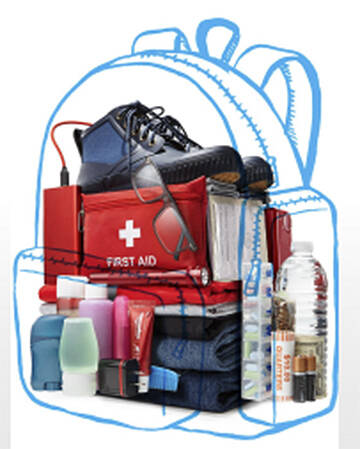Once a disaster strikes, it’s too late to prepare.
That’s the message given at a recent Disaster Preparedness seminar given by Anne LeSage, emergency management coordinator for the city of Bainbridge Island.
All types of emergencies can happen in the Pacific Northwest: Earthquakes, landslides, wildfires, tsunamis, radiation leaks, volcanic eruptions, severe winds and rain and snow storms, along with pandemics, one often not emphasized until recent years.
Sometimes people will think of having supplies at home, but disasters don’t always hit while you’re there. So a “Go Bag/Evacuation Kit” is recommended by LeSage.
In a backpack, you would put: water, snacks, first aid kit, flashlight, copies of important documents, change of clothes, cash, hygiene supplies and items specific to your household, such as for pets, children, etc.
Workplace and car supplies also could include: whistle, blanket or sleeping bag, dust mask, eyewear, poncho, cell phone, jumper cables, flares, ice scraper, maps, coat and cat litter, which helps with tire traction.
At home, you could plan for even more: a gallon of water per person per day, up to 30 days of non-perishable food, multipurpose tool and work gloves, camp stove, portable toilet or 5-gallon bucket, prescriptions, a generator and a weather radio.
But being prepared is much more than having supplies on hand. You need plans.
First is a Family Disaster Plan, so family or friends can pick up children at school. A Reunification Plan, somewhere in the community away from your home, where you can meet. An Emergency Contact List, out of state folks can be easier to reach in a local emergency. And a Map Your Neighborhood Plan to know who around you has what supplies and which skills.
Of course, finding out when a disaster happens as quickly as possible is key. The city has alerts from Nixie, Kitsap County has alerts called Rave, there’s social media, and there’s a wireless emergency alert system.
BI has many opportunities to get involved, including the Community Emergency Response Team, or CERT, where you learn skills to help others. BI also has an Emergency Medical Response Team; Medical Corp Reserves; BI Emergency Auxiliary Radio System, or BEARS, ham radio team; and Flotilla.
It also has 13 Disaster Hubs spread out on BI. The community centers offer stopgap services and are within walking distance of every home. They offer official information, limited shelter services, targeted medical care, basic sustenance and targeted psychological care.
After the powerpoint presentation, LeSage answered questions from attendees.
She said if a big earthquake hits, it’s best to shelter in place. She recommends staying outside your house on your or nearby property. If that is not safe, go to the nearest disaster hub. One is located within two miles. If you need help or can help others go there. If not, stay put.
If you can volunteer great, but be sure to register with the city to avoid liability. Upstream and downstream communications will come from the hub. Ham radio operators will be at each one in case cell phones are inoperable.
If a mountain blows its top the major concern is air quality, just like with a wildfire. Again, shelter in place, but in your home. N-95 masks, box fans, and air filters can help. The state and county would be involved if evacuations were needed. But “if all evacuate, where are we going?” LeSage asked, adding going east would be a challenge, not to mention toward the eruption.
As for radiation leaks from military bases in Kitsap County, LeSage again recommends sheltering in place. Seal up your home, turn off air conditioners, and stay in an interior room. “Time, distance and shielding are your best line of defense,” she said.



